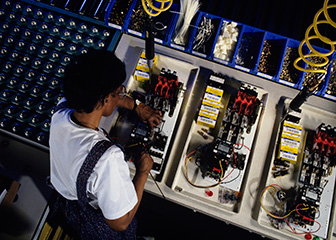
Assemblers and fabricators conduct quality checks for faulty components or mistakes in the assembly process.
Assemblers and fabricators assemble both finished products and the parts that go into them. They use tools, machines, and their hands to make engines, computers, aircraft, toys, electronic devices, and more.
Duties
Assemblers and fabricators typically do the following:
- Read and understand detailed schematics and blueprints
- Use hand tools or machines to assemble parts
- Conduct quality control checks
- Work closely with designers and engineers in product development
Assemblers and fabricators have an important role in the manufacturing process. They assemble both finished products and the pieces that go into them. The products encompass a full range of manufactured products, including aircraft, toys, household appliances, automobiles, computers, and electronic devices.
Changes in technology have transformed the manufacturing and assembly process. Modern manufacturing systems use robots, computers, programmable motion-control devices, and various sensing technologies. These systems change the way in which goods are made and affect the jobs of those who make them. Advanced assemblers must be able to work with these new technologies and use them to produce goods.
The job of an assembler or fabricator ranges from very easy to very complicated, requiring a range of knowledge and skills. Skilled assemblers putting together complex machines, for example, read detailed schematics or blueprints that show how to assemble the machine. After determining how parts should connect, they use hand or power tools to trim, shim, cut, and make other adjustments to fit components together and align them properly. Once the parts are properly aligned, they connect them with bolts and screws or weld or solder pieces together.
Quality control is important throughout the assembly process, so assemblers look for faulty components and mistakes in the assembly process. They help to fix problems before defective products are made.
Manufacturing techniques are moving away from traditional assembly line systems toward lean manufacturing systems, which use teams of workers to produce entire products or components. Lean manufacturing has changed the nature of the assemblers' duties.
It has become more common to involve assemblers and fabricators in product development. Designers and engineers consult manufacturing workers during the design stage to improve product reliability and manufacturing efficiency. Some experienced assemblers work with designers and engineers to build prototypes or test products.
Although most assemblers and fabricators are classified as team assemblers, others specialize in producing one type of product or do the same or similar tasks throughout the assembly process.
The following are types of assemblers and fabricators:
Aircraft structure, surfaces, rigging, and systems assemblers fit, fasten, and install parts of airplanes, space vehicles, or missiles, such as wings, fuselage, landing gear, rigging and control equipment, or heating and ventilating systems.
Coil winders, tapers, and finishers wind wire coils of electrical components used in a variety of electric and electronic products, including resistors, transformers, generators, and electric motors.
Electrical and electronic equipment assemblers build products such as electric motors, computers, electronic control devices, and sensing equipment. Automated systems have been put in place because many small electronic parts are too small or fragile for human assembly. Much of the remaining work of electrical and electronic assemblers is done by hand during the small-scale production of electronic devices used in all types of aircraft, military systems, and medical equipment. Production by hand requires these workers to use devices such as soldering irons.
Electromechanical equipment assemblers assemble and modify electromechanical devices such as household appliances, computer tomography scanners, or vending machines. The workers use a variety of tools, such as rulers, rivet guns, and soldering irons.
Engine and machine assemblers construct, assemble, or rebuild engines, turbines, and machines used in automobiles, construction and mining equipment, and power generators.
Structural metal fabricators and fitters cut, align, and fit together structural metal parts and may help weld or rivet the parts together.
Fiberglass laminators and fabricators laminate layers of fiberglass on molds to form boat decks and hulls, bodies for golf carts, automobiles, or other products.
Team assemblers work on an assembly line, but they rotate through different tasks, rather than specializing in a single task. The team may decide how the work is assigned and how different tasks are done. Some aspects of lean production, such as rotating tasks and seeking worker input on improving the assembly process, are common to all assembly and fabrication occupations.
Timing device assemblers, adjusters, and calibrators do precision assembling or adjusting of timing devices within very narrow tolerances.








